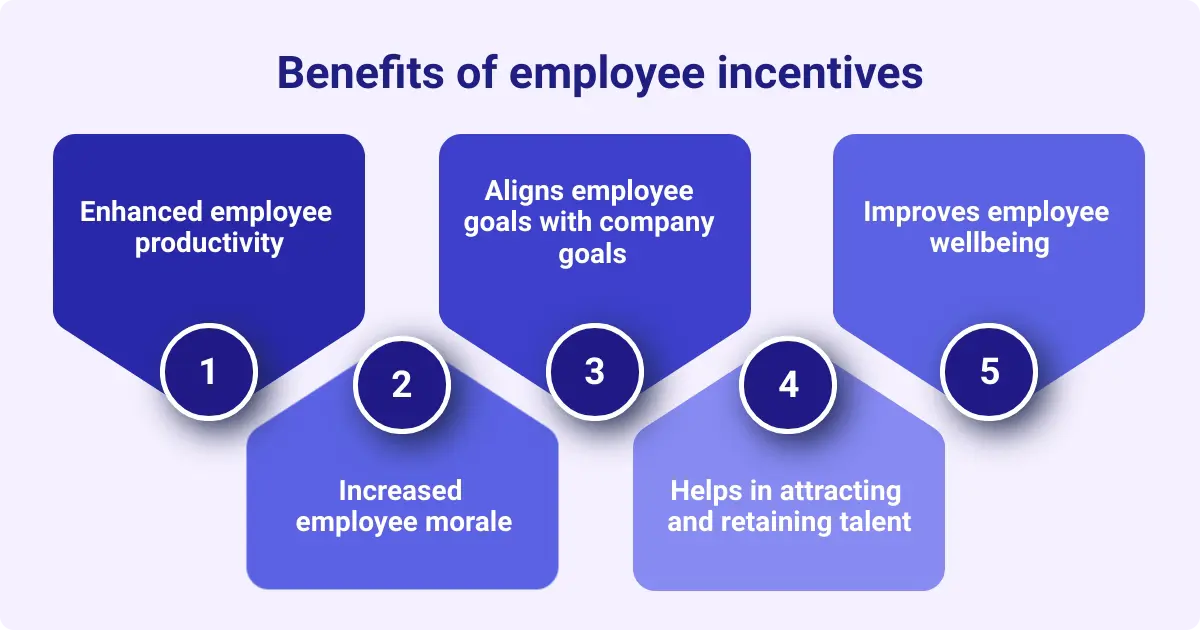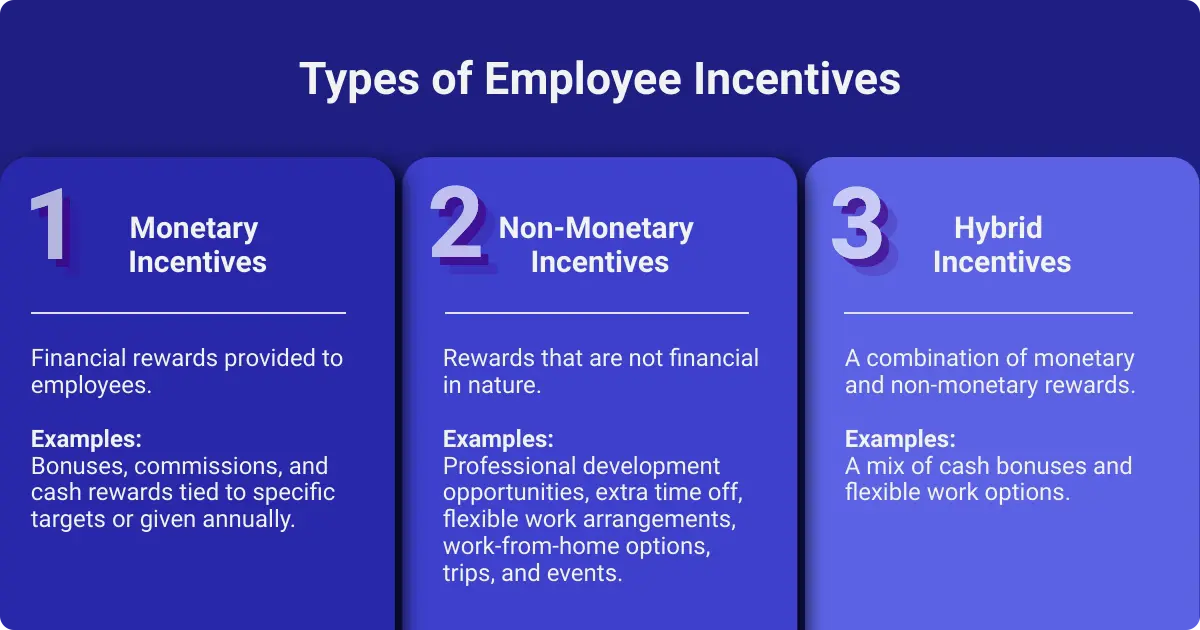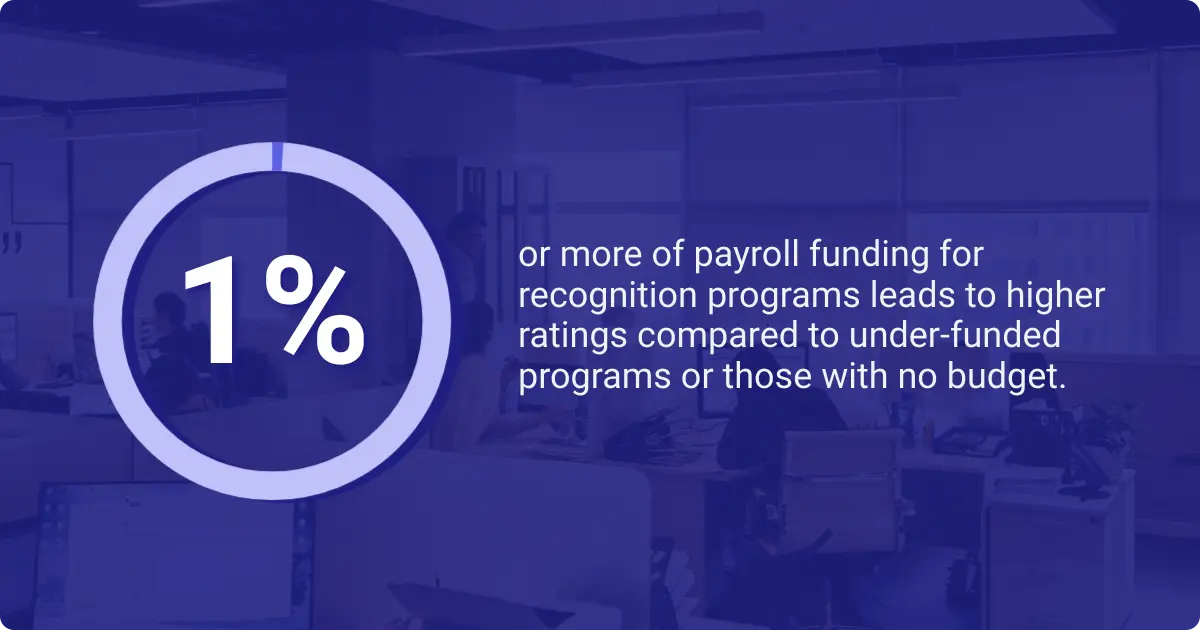What Are Employee Incentives? Are They Effective Strategies for Growth?
Inhaltsverzeichnis
- What are employee incentives?
- What are the benefits of employee incentives?
- How do incentives impact employee performance and engagement?
- What is the difference between employee benefits and employee incentives?
- What types of employee incentives do employers offer?
- How do you implement employee incentives at your company?
- How do companies fund employee incentives?
- Conclusion

Employee incentives are designed to motivate workers and create a more engaged work environment. And if your organization needs to grow, produce better work, be more efficient, and have a more proactive workforce, employee incentives should certainly be a line item on your balance sheet.
The current workforce is stressed and burned out, contributing to disengagement, turnover, and low morale. Your company can’t stop a pandemic (right?), and it can’t erase the stresses of life, but it can create an incentive program that rewards and acknowledges the work and efforts of its employees.
What are employee incentives?
Employee incentives are monetary or non-monetary (but still tangible) rewards, like points or gift vouchers, designed to motivate and engage employees. Striving for ambitious goals, managing tight deadlines, or improving efficiencies are all scenarios in which an incentive could be a valuable investment for a company.
Incentives are most effective when aligned with your company values, as you can reward the kind of effort and behavior you want to see more of. They are also given throughout the year to provide consistent boosts of motivation.
What are the benefits of employee incentives?
Beyond motivating, incentives encourage and coach. They help reduce turnover, improve morale, and increase productivity. They also reward and help retain high-performers who consistently do good work throughout the year.
Maybe you’re thinking it’s a little suspect that simply throwing money at the problem can meaningfully impact all those business metrics.
Well, you’d be right. Research from the European Economic Review on motivation and monetary incentives has shown that incentives alone won’t lead to better performanceÖffnet in einem neuen Tab for the employee or the company. You get the most value out of incentives by pairing them with recognition.
It is incentives combined with recognition, affirmations, and praise for the task completed that result in “improved performance, in terms of both quality and quantity of work.”

Enhanced employee productivity
Merit-based incentives motivate employees to work toward achieving them. As such, your organization is likely to see a boost in productivity as team members strive to hit certain targets to achieve different rewards.
Increased employee morale
People love gifts. And money. And generally special "treats" that reward them for their hard work. Incentives boost morale by making employees feel good – they feel recognized for their work and get a nice little dopamine hit in the process.
Aligns employee goals with company goals
While intrinsic motivation is important, external motivation has its place too. Creative incentive ideas put individual goals in parallel with company goals, having a positive compounding effect. After all, it's good for business when workers hit (or surpass) quotas, work together to win a new account, or take advantage of development opportunities.
Helps in attracting and retaining talent
A strong employee incentive program serves as a key differentiator to job candidates. It can be a welcome perk on top of a uniform salary or a means to meet individual must-haves, like remote work opportunities or extra time off.
The HR department uses several tools, practices, and techniques to screen the best fit for an organization. Want to know what they do? Here are 4 Ways to Attract and Retain Great Employees.
Improves employee wellbeing
Autonomy, connection, community, and feeling seen all make a tremendous impact on employee wellbeing. Employee recognition and other incentives help facilitate that.
How do incentives impact employee performance and engagement?
Incentives encourage employees to be more engaged with their work with the promise of a reward or perk at the end of the line, so to speak. But how exactly do they help employees do that? Let's dig deeper.
Sense of belonging
Positive affirmations and moments of recognition breed employee wellbeing and make them feel like they belong. How? They feel seen and appreciated for their contributions. It shows that their work has had a meaningful impact on the broader organization.
Employees feel valued
Similarly, rewards for a job well done show employees that they are valued and that their work isn't going unnoticed. In today's fast-paced work environment, taking a moment to say "thank you" can make all the difference.
Improve job satisfaction
Feeling connected and valued is a catalyst for job satisfaction. Incentives can be tied to employees' personal priorities – like having flexible work arrangements – so having such perks feels genuinely meaningful.
Contribute to a positive workplace culture
Happy employees make for a positive work environment. Meaningful incentives make for happy employees. It's a symbiotic relationship!
What is the difference between employee benefits and employee incentives?
Employee benefits are set offerings that are equally available to all full-time employees, including things like health insurance, retirement plans, and time off. Employee incentives are based on performance and specific targets. Only employees who reach these milestones receive the rewards or perks. It is a reward system for the employee experience made up of both non-monetary and monetary incentives.
What types of employee incentives do employers offer?
There are many different employee incentive ideas you can offer that will excite and motivate your employees while still making good business sense for your organization. Here are some employee incentive program examples.
Monetary, non-monetary, and hybrid incentives
Monetary incentives are financial rewards, like bonuses or commissions. These are often aligned with specific targets or are given annually. They can be added to a paycheck or given out as a cash bonus.
Non-monetary incentives are perks and rewards that are anything but money. This can include professional development opportunities, extra time off, flexible work arrangements or work-from-home time, a trip or event, and much more.
Of course, your employee incentive program could be a mix of the two, which can be called hybrid incentives. Many organizations like to offer a mix of both, particularly with the advent of employee recognition programs, which make non-monetary incentives easier than ever to facilitate.

Employee wellness incentives
Health plays a huge role in employee wellbeing, and offering a wellness incentive shows your employees that you recognize and value this. You can offer a wellness stipend, reward employees for being active, or even partner with a local gym or fitness service to offer subsidized or free memberships to employees.
Retention incentives
A great way to encourage lasting employment is to offer an employee retention bonus agreement. A stay bonus is a percentage raise in compensation or a one-off bonus that the employee will receive if they stay for a defined period. These can be useful in stressful periods or phases of high turnover.
Performance incentives
These are often monetary rewards employees can achieve once they hit a set milestone or target. That could be closing a certain number of sales, generating a certain amount of revenue, or another quantifiable milestone. Performance incentives are often touted as one of the best ways to motivate employees to increase productivity.
How do you implement employee incentives at your company?
For an effective employee incentive program, align employee appreciation efforts with organizational objectives. Whatever company goals you have, ensure your incentive plan ladders up to them. Here are some best practices for launching an effective employee incentive program:
Take care to do it right. Allow employees and leadership alike to ask questions and give feedback so the whole organization feels invested in the process. Incentives must be viewed as a valuable part of your workplace culture and not a means of competition or an empty gesture.
How do companies fund employee incentives?
A lot of companies have questions about how to fund rewards and recognition. Is it really something you can afford? The truth is, it might be simpler than you imagine.
According to an employee recognition survey, the sweet spot for values-based rewards and recognition investment is 1% or more of payroll.

Download the 2018 SHRM/Workhuman Employee Recognition Report now to gain insights on creating a human-centric work culture and enhancing your employer brand.
An important distinction for companies to make when considering employee incentives is to view them as investments rather than expenses.
An investment in employee incentives can make a dramatic difference in the experience and performance of your employees. Incentives can provide a spark to a disengaged workforce and serve as a steady drumbeat of appreciation throughout the year to keep your business at its best.
Are employee incentives taxable?
Monetary incentives or rewards are taxable. Employers have the option of withholding taxes at the standard income tax rate or at a flat rate for supplemental wages. For more details on different rules and exceptions, see the IRS guide to business expense resourcesÖffnet in einem neuen Tab for additional information.
Fringe benefits, such as workplace perks, discounts, and gifts, are subject to income tax withholding and employment taxes, according to the IRS. The employer must account for the fair market value of the benefits, which is generally more than whatever the employee had to pay if anything.
Common mistakes to avoid while implementing employee incentives
With so much supporting the obvious success and ROI of offering incentives, what are some mistakes to watch for?
A lack of clear objectives can lead to disorganization and confusion about the program. If you don't know how the program's objectives relate to your larger organizational objectives, chances are your program will lack cohesion and won't be as successful.
Inequitable distribution is a surefire way to impact employee morale and buy-in. Implicit bias can mean that some employees are rewarded more often than others. It's important to ensure that your range of incentives stretches equitably across your employees. Tools like Workhuman's Inclusion Advisor help ensure equity in every recognition interaction in real time.
Discover how Workhuman's Inclusion Advisor paired with Social Recognition, can transform your organization for the better.
Unhealthy competition is the enemy of a productive incentive program. If you make rewards too exclusive or difficult to reach, it could create a sense of competition amongst employees and turn financial incentives into a tool of division rather than productivity.
Feedback is an important part of every culture initiative, and if you ignore employees' feedback as the program takes hold, you could risk losing buy-in and participation. It's important to seek feedback regularly to ensure the program remains meaningful to employees and delivers on its set purpose.
Inconsistent or infrequent recognition can make employees feel neglected or resentful. Managers should aim to meet with each of their direct reports at least once a month, but likely more, to connect and share recognition. With enough data, you can identify the ideal number of recognition moments per year and set that as a standard for all managers.
Conclusion
Employee incentives and rewards can help combat the stress being felt by the workforce. They can help drive engagement and facilitate connections across the organization.
Curious about the future of employee benefits and how it could impact your existing program? Check out our Human Workplace Index report to learn more about how this cultural cornerstone will evolve.
If you're ready to get serious about your workplace culture, explore how the Workhuman Cloud can transform your organization's employee incentives program.
About the author
Maeve Ginsberg
Mike ist ein leitender Content-Marketing-Spezialist bei Workhuman, wo er über die nächste Ära des Arbeitsplatzes schreibt. Außerhalb des Arbeitsplatzes ist er ein begeisterter Gärtner, ein häufiger Radfahrer, ein ständig besser werdender Koch und ein begeisterter Fantasy-Sportler.